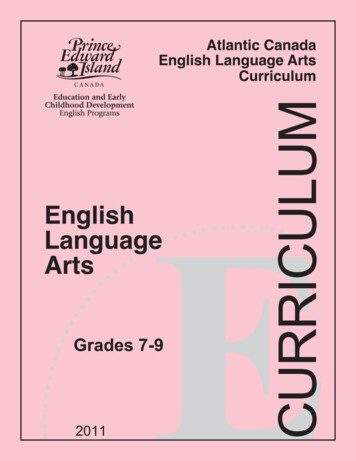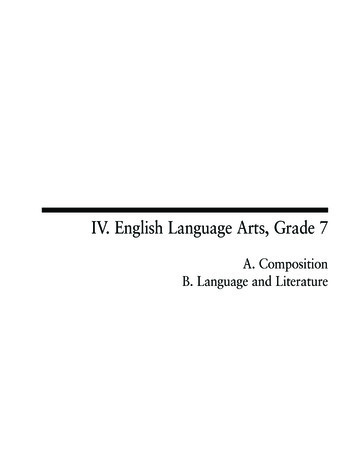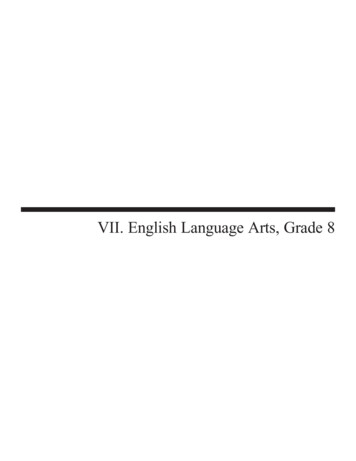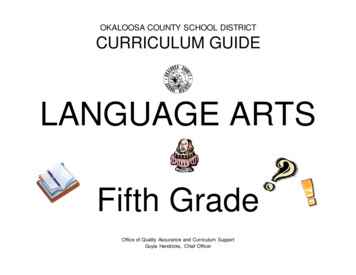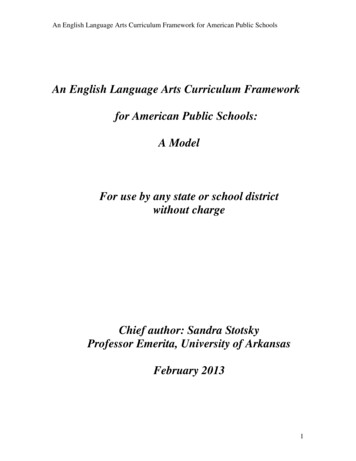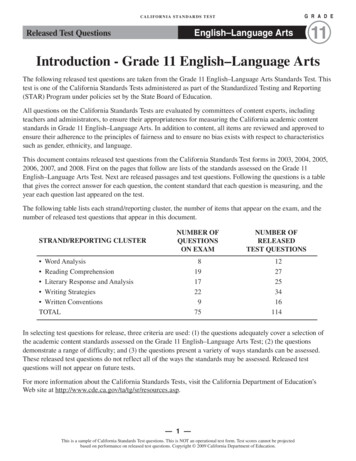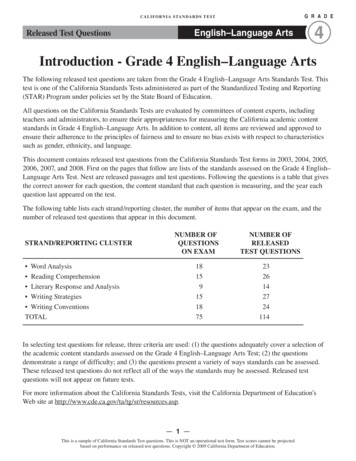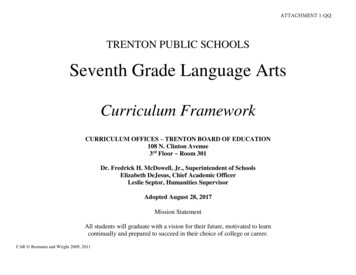
Transcription
ATTACHMENT 1-QQTRENTON PUBLIC SCHOOLSSeventh Grade Language ArtsCurriculum FrameworkCURRICULUM OFFICES – TRENTON BOARD OF EDUCATION108 N. Clinton Avenue3rd Floor Room 301Dr. Fredrick H. McDowell, Jr., Superintendent of SchoolsElizabeth DeJesus, Chief Academic OfficerLeslie Septor, Humanities SupervisorAdopted August 28, 2017Mission StatementAll students will graduate with a vision for their future, motivated to learncontinually and prepared to succeed in their choice of college or career.CAR Bormann and Wright 2009, 2011
Unit One: Unlocking the TextGrade Level: 7Timeframe: 10 weeksTime Frame: September-November (10 Weeks)Unit Focus: Reading-Narrative; Writing-NarrativeEssential Questions How do readers use authors’ clues to make inferences?What key concepts do fiction and non-fiction share?How does an author’s word choice impact an audience?How does point of view affect the theme of a piece of writing?What aspects of a text are developed to determine the central idea of a piece of writing?New Jersey Student Learning Standards (NJSLS)Standards/Cumulative Progress Indicators (Taught and Assessed):Reading Literature:Key Ideas and DetailsRL.7.1 Cite several pieces of textual evidence and make relevant connections to support analysis of what the text says explicitly as well as inferences drawnfrom the text.RL.7.2 Determine a theme or central idea of a text and analyze its development over the course of the text; provide an objective summary of the text.RL.7.3 Analyze how particular elements of a story or drama interact (e.g., how setting shapes the characters or plot).Craft and StructureRL.7.4 Determine the meaning of words and phrases as they are used in a text, including figurative and connotative meanings; analyze the impact of rhymesand other repetitions of sounds (e.g., alliteration) on a specific verse or stanza of a poem or section of a story or drama.RL.7.5 Analyze how a drama's or poem's form or structure (e.g., soliloquy, sonnet) contributes to its meaningRL.7.6 Analyze how an author develops and contrasts the points of view of different characters or narrators in a text.Integration of Knowledge and IdeaRL.7.7. Compare and contrast a written story, drama, or poem to its audio, filmed, staged, or multimedia version, analyzing the effects of techniques uniqueto each medium (e.g., lighting, sound, color, or camera focus and angles in a film).RL.7.9. Compare, contrast and reflect on (e.g. practical knowledge, historical/cultural context, and background knowledge) a fictional portrayal of a time,place, or character and a historical account of the same period as a means of understanding how authors of fiction use or alter history.Reading Informational Text:Key Ideas and DetailsRI.7.1 Cite several pieces of textual evidence and make relevant connections to support analysis of what the text says explicitly as well as inferences drawnfrom the text.CAR Bormann and Wright 2009, 2011
RI.7.2 Determine two or more central ideas in a text and analyze their development over the course of the text; provide an objective summary of the text.Craft and StructureRI.7.6 Determine an author's point of view or purpose in a text and analyze how the author distinguishes his or her position from that of others.Writing: NarrativeText Types and PurposesW.7.3. Write narratives to develop real or imagined experiences or events using effective technique, well-chosen details, and well-structured eventsequencesW.7.3AEngage and orient the reader by establishing a context and point of view and introducing a narrator and/or characters; organize an event sequence thatunfolds naturally and logically.W.7.3BUse narrative techniques, such as dialogue, pacing, and description, to develop experiences, events, and/or characters.W.7.3CUse a variety of transition words, phrases, and clauses to convey sequence and signal shifts from one time frame or setting to another.W.7.3DUse precise words and phrases, relevant descriptive details, and sensory language to capture the action and convey experiences and events.W.7.3EProvide a conclusion that follows from and reflects on the narrated experiences or events.Production and Distribution of WritingW.7.4. Produce clear and coherent writing in which the development, organization, voice and style are appropriate to task, purpose, and audience.W.7.5 With some guidance and support from peers and adults, develop and strengthen writing as needed by planning, revising, editing, rewriting, or trying anew approach, focusing on how well purpose and audience have been addressed.W.7.6 Use technology, including the Internet, to produce and publish writing and present the relationships between information and ideas efficiently as wellas to interact and collaborate with others.Range of Writing:W.7.10. Write routinely over extended time frames (time for research, reflection, metacognition/self-correction and revision) and shorter time frames (asingle sitting or a day or two) for a range of discipline-specific tasks, purposes, and audiences.Primary Speaking and Listening:Comprehension and CollaborationSL.7.1. Engage effectively in a range of collaborative discussions (one-on-one, in groups, and teacher-led) with diverse partners on grade 7 topics, texts, andissues, building on others' ideas and expressing their own clearly.SL.7.1.A. Come to discussions prepared, having read or researched material under study; explicitly draw on that preparation by referring to evidence on thetopic, text, or issue to probe and reflect on ideas under discussion.SL.7.1.B. Follow rules for collegial discussions, track progress toward specific goals and deadlines, and define individual roles as needed.CAR Bormann and Wright 2009, 2011
SL.7.1.C. Pose questions that elicit elaboration and respond to others' questions and comments with relevant observations and ideas that bring the discussionback on topic as needed.SL.7.1.D. Acknowledge new information expressed by others and, when warranted, modify their own views.Presentation of Knowledge and IdeasSL.7.2. Analyze the main ideas and supporting details presented in diverse media and formats (e.g., visually, quantitatively, orally) and explain how the ideasclarify a topic, text, or issue under study.SL.7.4. Present claims and findings, emphasizing salient points in a focused, coherent manner with pertinent descriptions, facts, details, and examples; useappropriate eye contact, adequate volume, and clear pronunciation.SL.7.6 Adapt speech to a variety of contexts and tasks, demonstrating command of formal English when indicated or appropriate. (See grade 7 Languagestandards 1 and 3 here for specific expectations.)Primary Language Standards:Comprehension and Collaboration:SL.7.1. Engage effectively in a range of collaborative discussions (one-on-one, in groups, and teacher-led) with diverse partners on grade 7 topics, texts, andissues, building on others' ideas and expressing their own clearly.SL.7.1.A. Come to discussions prepared, having read or researched material under study; explicitly draw on that preparation by referring to evidenceon the topic, text, or issue to probe and reflect on ideas under discussion.SL.7.1.B. Follow rules for collegial discussions, track progress toward specific goals and deadlines, and define individual roles as needed.SL.7.1.C. Pose questions that elicit elaboration and respond to others' questions and comments with relevant observations and ideas that bring thediscussion back on topic as needed.SL.7.1.D. Acknowledge new information expressed by others and, when warranted, modify their own views.Presentation of Knowledge and Ideas:SL.7.4. Present claims and findings, emphasizing salient points in a focused, coherent manner with pertinent descriptions, facts, details, and examples; useappropriate eye contact, adequate volume, and clear pronunciation.SL.7.6 Adapt speech to a variety of contexts and tasks, demonstrating command of formal English when indicated or appropriate. (See grade 7 Languagestandards 1 and 3 here for specific expectations.)Primary Language Standards:L.7.1.C Place phrases and clauses within a sentence, recognizing and correcting misplaced and dangling modifiers.L.7.2.A Use a comma to separate coordinate adjectives (e.g., It was a fascinating, enjoyable movie but not He wore an old[,] green shirt).L.7.2.B. Spell correctly.Knowledge of Language:L.7.3. Use knowledge of language and its conventions when writing, speaking, reading, or listening.L.7.3.A. Choose language that expresses ideas precisely and concisely, recognizing and eliminating wordiness and redundancy.Vocabulary Acquisition and Use:L.7.4. Determine or clarify the meaning of unknown and multiple-meaning words or phrases based on grade 7 reading and content, choosing flexibly from arange of strategies.CAR Bormann and Wright 2009, 2011
L.7.4.A. Use context (e.g., the overall meaning of a sentence or paragraph; a word's position or function in a sentence) as a clue to the meaning of aword or phrase.L.7.4.C. Consult reference materials (e.g., dictionaries, glossaries, thesauruses), both print and digital, to find the pronunciation of a word or determineor clarify its precise meaning or its part of speech.L.7.4.D. Verify the preliminary determination of the meaning of a word or phrase (e.g., by checking the inferred meaning in context or in a dictionary).L.7.6. Acquire and use accurately grade-appropriate general academic and domain-specific words and phrases; gather vocabulary knowledge whenconsidering a word or phrase important to comprehension or expression.StandardSLO- WALTFormative AssessmentActivities and ResourcesReflectionInstructional PlanAcademic Vocabulary for Unit 1genre, context clues, setting, plot, conflict (internal, external), character, character traits, protagonist, antagonist,characterization, conflict, perspective, point of view, author’s craft literary elements, context clues, point of view, charactermotivation, imagery, style, literary elements, flashback, foreshadowing, imagery, style, elaboration, rising action, climax,exposition, omniscient, falling action, figurative language, dialogue, allusion, ironyPre-assessment- Online diagnostic through EdConnectWeek One- Focus StandardsRL.7.1 Cite several pieces of textual evidence and make relevant connections to support analysis of what the text says explicitly as well as inferences drawnfrom the text.RI 7.1 Cite several pieces of textual evidence and make relevant connections to support analysis of what the text says explicitly as well as inferences drawnfrom the text.RL 7.6 Analyze how an author develops and contrasts the points of view of different characters or narrators in a text.RI.7.6 Determine an author's point of view or purpose in a text and analyze how the author distinguishes his or her position from that of others.RL 7.1Infer what the writer means but Formative QuestionsHolt McDougal LiteratureRI 7.1has not stated using evidenceHow does knowledge andmyrhw.comfrom the text Support thinkingselection of textual evidenceiReadybeyond the text with specificdeepen comprehension of text?Newselaevidence based on personalWhat is the difference betweenAchieve 3000experience, or knowledge orwhat the text says explicitly andevidence from the textwhat is inferred?Anthology ConnectionsFormative StrategiesR.L.7.1Pre-Assessment DiagnosticSeventh GradeDo Now’sThe Last DogClass discussionsThe Scholarship JacketExit TicketsThe War of the WallCAR Bormann and Wright 2009, 2011
RL 7.1RI 7.1Make and support predictionswith evidence from the text orfrom knowledge or genreCAR Bormann and Wright 2009, 2011Checks for understandingDark they Were, And Golden EyedMaggie and milly and molly and may/whoare you, little i/old age sticksThe Charge of the Light Brigade/ TheHighwaymanTwo Haiku/Fireflies/Fireflies in the GardenPrometheus/Orpheus and EurydiceFrom BeowulfFrom Young ArthurOther Activities Analyzing and creating editorials Engage in small group discussions Participate in Jigsaws Creating a character interview Change a major element of the textt show the main characters reaction Rewrite the ending of a storyFormative QuestionsHow does knowledge andselection of textual evidencedeepen comprehension of text?What is the difference betweenwhat the text says explicitly andwhat is inferred?Formative StrategiesPre-Assessment DiagnosticDo Now’sClass discussionsExit TicketsChecks for understandingHolt McDougal Literaturemyrhw.comiReadyNewselaAchieve 3000Anthology ConnectionsR.L.7.1Seventh GradeThe Last DogThe Scholarship JacketThe War of the WallDark they Were, And Golden EyedMaggie and milly and molly and may/whoare you, little i/old age sticksThe Charge of the Light Brigade/ TheHighwaymanTwo Haiku/Fireflies/Fireflies in the GardenPrometheus/Orpheus and Eurydice
From BeowulfFrom Young ArthurOther Activities Analyzing and creating editorials Engage in small group discussions Participate in Jigsaws Creating a character interview Change a major element of the textto show the main charactersreaction Rewrite the ending of a storyRL 7.1RL 7.1Continuously check with theevidence in a text to ensure thatwriting reflects understandingFormative QuestionsHow does knowledge andselection of textual evidencedeepen comprehension of text?What is the difference betweenwhat the text says explicitly andwhat is inferred?Formative StrategiesPre-Assessment DiagnosticDo Now’sClass discussionsExit TicketsChecks for understandingHolt Literaturemyrhw.comiReadyNewselaAchieve 3000Anthology ConnectionsR.L.7.1Seventh GradeThe Last DogThe Scholarship JacketThe War of the WallDark they Were, And Golden EyedMaggie and milly and molly and may/whoare you, little i/old age sticksThe Charge of the Light Brigade/ TheHighwaymanTwo Haiku/Fireflies/Fireflies in the GardenPrometheus/Orpheus and EurydiceFrom BeowulfFrom Young ArthurOther ActivitiesCAR Bormann and Wright 2009, 2011
RL 7.6Derive the author’s purpose andstance even when implicitlystatedAnalyzing and creating editorialsEngage in small group discussionsParticipate in JigsawsCreating a character interviewChange a major element of the textt show the main characters reactionRewrite the ending of a storFormative QuestionsHow do readers analyze point ofview and purpose in a text?How does a change in point ofview affect our perception?Holt McDougal Literaturemyrhw.comiReadyNewselaAchieve 3000Formative StrategiesPre-Assessment DiagnosticDo Now’sClass discussionsExit TicketsChecks for UnderstandingAnthology ConnectionsRL 7.6Text Analysis Workshop: Character andPoint of ViewThe Scholarship JacketA Retrieved ReformationOther Activities News reports from variousperspectives Critique author’s point of view byproviding a persuasive rebuttal Read and analyze two accounts ofthe same experienceRL 7.6Analyze the selection of genre inrelation to inferred writer’spurpose for a range of textsCAR Bormann and Wright 2009, 2011Formative QuestionsHow do readers analyze point ofview and purpose in a text?Holt McDougal Literaturemyrhw.comiReadyNewsela
How does a change in point ofview affect our perception?Formative StrategiesPre-Assessment DiagnosticDo Now’sClass discussionsExit TicketsChecks for UnderstandingAchieve 3000Anthology ConnectionsRL 7.6Text Analysis Workshop: Character andPoint of ViewThe Scholarship JacketA Retrieved ReformationOther Activities News reports from variousperspectives Critique author’s point of view byproviding a persuasive rebuttal Read and analyze two accounts ofthe same experience.RI 7.6Analyze texts to determine thewriter’s point of view or bias,identifying specific languagethat reveals bias or qualifies aspropagandaFormative QuestionsHow do readers analyze point ofview and purpose in a text?How does a change in point ofview affect our perception?Formative StrategiesPre-Assessment DiagnosticDo Now’sClass discussionsExit TicketsChecks for UnderstandingHolt McDougal Literaturemyrhw.comiReadyNewselaAchieve 3000Anthology ConnectionsR.I.7.6HomelessWhy We Shouldn’t Go to MarsGreat White SharksFrom It’s Not About the Bike/from 23 Daysin JulyOther ActivitiesCAR Bormann and Wright 2009, 2011
RI 7.6Explain and evaluate theeffectiveness of the techniquesthe author uses to distinguishhis/her point of view fromothersFormative QuestionsHow can we differentiate betweenthe author’s central argument andcounter argument that the authorpresents in the same piece?Why is it important toacknowledge and understandopposing viewpoints?Formative StrategiesPre-Assessment DiagnosticDo Now’sClass discussionsExit TicketsChecks for UnderstandingIntroduce the rhetorical triangle andinvestigate how audience, subjectand author interact.Read an essay and identify thecounter arguments.Quick writes used to have studentscreate counter arguments.Provide a model essay based upon acommonly held belief and askstudents to paraphrase both theauthor’s and opposing viewpoint.Holt McDougal Literaturemyrhw.comiReadyNewselaAchieve 3000Anthology ConnectionsR.I.7.6HomelessWhy We Shouldn’t Go to MarsGreat White SharksFrom It’s Not About the Bike/from 23 Daysin JulyOther Activities Introduce the rhetorical triangle andinvestigate how audience, subjectand author interact. Read an essay and identify thecounter arguments. Quick writes used to have studentscreate counter arguments.CAR Bormann and Wright 2009, 2011
Provide a model essay based upon acommonly held belief and askstudents to paraphrase both theauthor’s and opposing viewpoint.Week Two- Focus StandardsRL.7.4. Determine the meaning of words and phrases as they are used in a text, including figurative and connotative meanings; analyze the impact of rhymes andother repetitions of sounds (e.g., alliteration) on a specific verse or stanza of a poem or section of a story or drama.RL.7.2. Determine a theme or central idea of a text and analyze its development over the course of the text; provide an objective summary of the textRI.7.2. Determine two or more central ideas in a text and analyze their development over the course of the text; provide an objective summary of the textW.7.3. Write narratives to develop real or imagined experiences or events using effective technique, relevant descriptive details, and well-structured eventsequencesAcademic Vocabularygenre, context clues, setting, plot, conflict (internal, external), character, character traits, protagonist, antagonist, characterization, conflict, perspective, point ofview, author’s craft literary elements, context clues, point of view, character motivation, imagery, style, literary elements, flashback, foreshadowing, imagery,style, elaboration, rising action, climax, exposition, omniscient, falling action, figurative language, dialogue, allusion, ironyRL 7.4Analyze why the author used aFormative QuestionsHolt McDougal Literaturespecific word choice or soundHow does word choice impact the myrhw.comdevice and it’s on the readeroverall meaning of the text?iReadyHow does the author’s use ofNewselastructure affect the meaning ofAchieve 3000the text? 3. How does the author’spoint of view and purpose shapeAnthology Connectionsand direct the text?RL 7.4Formative StrategiesThe Charge of the Light Brigade/TheWord SortHighwaymanDo Now’sTwo Haiku/Fireflies/Fireflies in the GardenClass discussionsThe Delight Song of Tsoai-Talee/Four SkinnyExit TicketsTreesChecks for UnderstandingText Analysis Workshop: Mood and Stylemaggie and mully and molly and may/whoare you, little i/old age sticksThe NamesOther Activities Figurative Language Chart depictingexamplesCAR Bormann and Wright 2009, 2011
RL 7.4Evaluate the effectiveness ofthe author’s word choice orsound deviceFormative QuestionsHow does word choice impact theoverall meaning of the text?How does the author’s use ofstructure affect the meaning ofthe text? 3. How does the author’spoint of view and purpose shapeand direct the text?Formative StrategiesDo Now’sClass discussionsExit TicketsChecks for UnderstandingCreate an advertisement utilizingfigurative languageCompile a poetry booklet depictingexamples of figurative languageHolt McDougal Literaturemyrhw.comiReadyNewselaAchieve 3000Anthology ConnectionsRL 7.4The Charge of the Light Brigade/TheHighwaymanTwo Haiku/Fireflies/Fireflies in the GardenThe Delight Song of Tsoai-Talee/Four SkinnyTreesText Analysis Workshop: Mood and Stylemaggie and mully and molly and may/whoare you, little i/old age sticksThe NamesOther Activities Figurative Language Chart depictingexamples Create an advertisement utilizingfigurative language Compile a poetry booklet depictingexamples of figurative languageCAR Bormann and Wright 2009, 2011
RL 7.2RI 7.2RL 7.2RI 7.2Analyze the development of thetheme or central idea over thecourse of the fictional text,including the relationshipbetween characters, setting,and plot over the course of atextFormative QuestionsHow does determining the centralidea of the text contribute tounderstanding the text?How do supporting ideas help todevelop the central idea?Formative StrategiesDo Now’sClass discussionsExit TicketsChecks for UnderstandingHolt McDougal Literaturemyrhw.comiReadyNewselaAchieve 3000Provide a statement of atheme(s) or a central idea(s) of afictional text, based on textualevidence and explain the themeor central idea of a fictionalpiece using key details asFormative QuestionsCan a central idea change?How do supporting ideas help todevelop the central idea?Formative StrategiesDo Now’sHolt McDougal Literaturemyrhw.comiReadyNewselaAchieve 3000CAR Bormann and Wright 2009, 2011Anthology ConnectionsRL 7.2RI 7.2A Wall of Remembrance/A Mother’sWords/U.S Involvement in VietnamText Analysis Workshop: UnderstandingThemeAmigo BrothersThe War of the WallTwo Haiku/Fireflies/Fireflies in the GardenFrom It’s Not About the Bike/from 23 Daysin JulyText Analysis Workshop: Reading forInformationOther Activities Quote interpretation. Collage depicting meaning. Write a book review Illustrate a story in chronologicalorder. Creating an outline Generate a Summary Participate in Jigsaws
RL 7.2RI 7.2evidence, including details fromthe beginning, middle, and endof the textClass discussionsExit TicketsChecks for UnderstandingAnthology ConnectionsRL 7.2RI 7.2A Wall of Remembrance/A Mother’sWords/U.S Involvement in VietnamText Analysis Workshop: UnderstandingThemeAmigo BrothersThe War of the WallTwo Haiku/Fireflies/Fireflies in the GardenFrom It’s Not About the Bike/from 23 Daysin JulyText Analysis Workshop: Reading forInformationOther Activities Quote interpretation. Collage depicting meaning. Write a book review Illustrate a story in chronologicalorder. Creating an outline Generate a Summary Participate in JigsawsSummarize the text objectively,capturing the main ideas andDistinguish between essentialand nonessential details of atext to create an objectivesummary of the textFormative QuestionsWhat are the elements of a goodsummary?How does a reader write asummary without personalopinions and judgements?Formative StrategiesOne Sentence SummaryDo Now’sClass discussionsExit TicketsChecks for UnderstandingHolt McDougal Literaturemyrhw.comiReadyNewselaAchieve 3000CAR Bormann and Wright 2009, 2011Anthology ConnectionsRL 7.2RI 7.2A Wall of Remembrance/A Mother’sWords/U.S Involvement in Vietnam
Text Analysis Workshop: UnderstandingThemeAmigo BrothersThe War of the WallTwo Haiku/Fireflies/Fireflies in the GardenFrom It’s Not About the Bike/from 23 Daysin JulyText Analysis Workshop: Reading forInformationOther Activities Quote interpretation. Collage depicting meaning. Write a book review Illustrate a story in chronologicalorder. Creating an outline Generate a Summary Participate in JigsawsW.7.3AEngage the reader with a storyhook; introduce the narratorand/or characters and Establisha point of view and backgroundstoryFormative QuestionsHow does point of view affect thedirection a story will take?Why is precise and vivid languagenecessary to create narrativetexts?Formative StrategiesDo Now’sClass discussionsExit TicketsChecks for UnderstandingHolt McDougal Literaturemyrhw.comiReadyNewselaAchieve 3000Anthology ConnectionsW 7.3Writing Workshop: Short StoryWriting Narrative: Personal NarrativeOther Activities Write an alternative ending a story Write a story from the perspectiveof a different character Create a narrative using graphicorganizers (for example a plotCAR Bormann and Wright 2009, 2011
CAR Bormann and Wright 2009, 2011diagram) to list sequence of eventsduring the brainstorming stages ofthe writing process.Dissect a current reading piece toidentify story elements prior tocreating their own composition.,thus leading to writing.Create an activity to emphasizemechanical and usage elementssuch as quotation marks, adjectives,and adverbs. Write a class narrativestory (“round-robin style”). –possible activity is to assign eachstudent a specific length to write (aparagraph) about a teacher directedtopic.Create a graphic novel (comic bookstyle).Using a graphic organizer, such as aVenn Diagram, determine twocharacters’ different perspectives onthe same event—Be more specificabout sources: The True Story of theThree Little Pigs, Wicked
W 7.3BOrganize an event sequencethat unfolds naturally andlogically and use narrativetechniques effectively todevelop experiences, events,and/orcharactersW7.3 CTransition from one idea tothe next by usingappropriate words andphrasesW 7.3 DUse figurative language to aidin the description of ideas byusing sensory and specificlanguageCAR Bormann and Wright 2009, 2011Formative QuestionsHow does point of view affect thedirection a story will take?Why is precise and vivid languagenecessary to create narrativetexts?Formative StrategiesDo Now’sClass discussionsExit TicketsPre-writingFirst draftsChecks for UnderstandingIndividual ConferencingFormative QuestionsHow does point of view affect thedirection a story will take?Why is precise and vivid languagenecessary to create narrativetexts?Formative StrategiesDo Now’sClass discussionsExit TicketsPre-writingFirst draftsChecks for UnderstandingIndividual ConferencingFormative QuestionsHow does point of view affect thedirection a story will take?Why is precise and vivid languagenecessary to create narrativetexts?Formative Strategies
Do Now’sClass discussionsExit TicketsPre-writingFirst draftsChecks for UnderstandingIndividual ConferencingWeek Three- Focus StandardsRL.7.3. Analyze how particular elements of a story or drama interact (e.g., how setting shapes the characters or plot).RL 7.5. Analyze how a drama’s or poems form or structure (e.g, soliloquy, sonnet) contribute to its meaning.W 7.3 Write narratives to develop real or imagined experiences or events using effective technique, relevant descriptive details, and well-structured eventsequencesRL 7.3Analyze how the plot andFormative QuestionsHolt McDougal Literaturesetting affect theHow does the interaction of storymyrhw.comactions/choices of theelements shape understanding?iReadycharacters and the impact of the Formative StrategiesNewselarelationship betweenPre-Assessment DiagnosticAchieve 3000characters, setting, and plot onDo Now’sthe readerClass discussionsAnthology ConnectionsExit TicketsText Analysis Workshop: Plot, Setting,Checks for UnderstandingCharacterSeventh GradeThe Last DogRikki-tikki-taviText Analysis Workshop: Character andPoint of ViewZebraAmigo BrothersText Analysis Workshop: Mood and StyleDark They Were, and Golden-EyedText Analysis Workshop: Myths, Legends,Epics and TalesFrom BeowulfFrom Young ArthurOther Activities Plot diagramCAR Bormann and Wright 2009, 2011
RL 7.3Evaluate the author’seffectiveness in determiningthe interactions betweencharacter, setting and plotFormative QuestionsHow can you determine whetherthe author was successful increating connections between thecharacters, setting and plot?Formative StrategiesPre-Assessment DiagnosticDo Now’sClass discussionsExit TicketsChecks for UnderstandingCharacter T-ChartCharacter InterviewDevelop a comic strip.Participate in Reader’s Theater.Holt McDougal Literaturemyrhw.comiReadyNewselaAchieve 3000Anthology ConnectionsText Analysis Workshop: Plot, Setting,CharacterSeventh GradeThe Last DogRikki-tikki-taviText Analysis Workshop: Character andPoint of ViewZebraAmigo BrothersText Analysis Workshop: Mood and StyleDark They Were, and Golden-EyedText Analysis Workshop: Myths, Legends,Epics and TalesFrom BeowulfFrom Young ArthurOther Activities Plot diagram Character T-Chart Character Interview Develop a comic strip.CAR Bormann and Wright 2009, 2011
RL 7.5Describe the form andstructure of a drama, poem ornonfiction textFormative QuestionsWhat are the different formswhen writing a dram, poem ornonfiction text?Formative StrategiesPre-Assessment DiagnosticDo Now’sClass discussionsExit TicketsChecks for UnderstandingParticipate in Reader’s Theater.Holt McDougal Literaturemyrhw.comiReadyNewselaAchieve 3000Anthology ConnectionsMaggie and milly and molly and may/whoare you, little i/old age sticksText Analysis Workshop: AppreciatingPoetryThe NamesThe Charge of the Light Brigade/TheHighwaymanTwo Haiku/Fireflies/Fireflies in the GardenOther Activities Participate in literarycenters/circles. Compare various types of poetry. Write song lyrics for a theatricalreview. Alter a chapter from a selectednovelRL 7.5Explain how text structureimpacts overall meaning oftext and why an authorchooses a specific form orstructureCAR Bormann and Wright 2009, 2011Formative QuestionsHow does the structure of a textcontribute to its meaning?Formative StrategiesPre-Assessment DiagnosticDo Now’sClass discussionsExit TicketsHolt McDougal Literaturemyrhw.comiReadyNewselaAchieve 3000Anthology Connections
Checks for UnderstandingMaggie and milly and molly and may/whoare you, little i/old age sticksText Analysis Workshop: AppreciatingPoetryThe NamesThe Charge of the Light Brigade/TheHighwaymanTwo Haiku/Fireflies/Fireflies in the GardenOther Activities
Aug 28, 2017 · Seventh Grade Language Arts . (See grade 7 Language standards 1 and 3 here for specific expectations.) . Holt McDougal Literature myrhw.com iReady Newsela Achieve 3000 Anthology Connections R.L.7.1 Seventh Grade
